Super seeds like chia and sabja (basil) are becoming popular for their impressive nutritional profile and health benefits. Sabja seeds have a long history of use in Ayurveda. Its properties are well-documented in Ayurvedic texts and have been used in Ayurvedic treatment for over 1000 years. On the other hand, the benefits of promoting energy, digestion, and overall vitality of chia seeds also align well with the Ayurvedic goals of getting healthy with balanced nutrition. Since chia and sabja seeds have comparable nutritional profiles, people often wonder which is more beneficial for health. In this article, we will explore the chia seeds vs sabja seeds’ benefits for health, and nutrition differences, and which seed might be better for specific health needs.
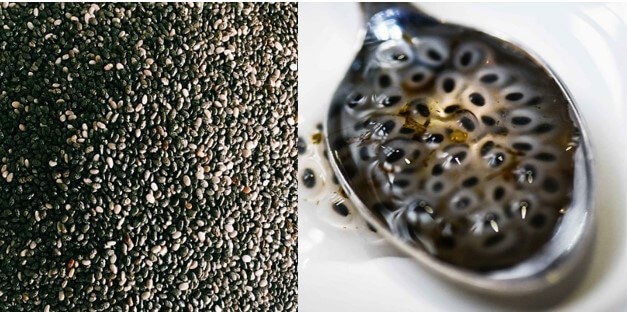
What are Chia Seeds and Sabja Seeds?
Chia seeds and sabja seeds (basil seeds) have earned the status of “super seeds”, “wonder foods”, “new gold”, “super nutrients”, or “seeds of the 21st century” due to their rich nutritional properties and amazing health benefits.
What are Chia Seeds?
The botanical name of chia seeds is Salvia hispanica L. These are the tiny, edible seeds of the Salvia hispanica plant, which belongs to the mint family. They are native to Mexico and South America. The name “chia” comes from an Aztec word which means “oily” since they are a good source of Omega-3 fatty acids, a type of healthy fats. They are oval-shaped, gray in color and have black and white spots on them. When chia seeds are soaked in water they absorb up to 12 times their weight and form a gel-like coating. They taste mild and nutty and are popular in smoothies, pudding, and other recipes.
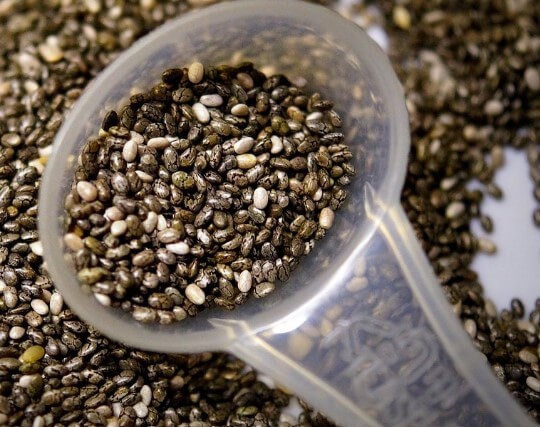
Image courtesy: needpix.com
Chia Seeds Nutritional Value
The nutritional value of chia seeds, as derived from Wikipedia is as follows:
- Water Content: Dried chia seeds are very low in water (6%).
- Carbohydrates: 42%
- Protein: 16%
- Fat: 31%
- Calories: 486 calories per 100 grams
- Vitamin B1 (Thiamin): 52% of Daily Value (DV)
- Vitamin B3 (Niacin): 55% of DV
- Vitamin B2 (Riboflavin): 13% of DV
- Folate: 12% of DV
- High levels of minerals like calcium, iron, magnesium, manganese, phosphorous, and zinc (20% or more of DV)
Chia seed oil is rich in healthy fats, particularly unsaturated fats. It contains Alpha-linolenic acid (ALA) which is an important Omega-3 fatty acid. 17-26% of total fat is Linoleic acid which is an Omega-6 fatty acid. It is low in saturated fats which makes it heart-friendly.
Chia Seeds Health Benefits
Let us take a quick look at the health benefits of chia seeds:
1.) Chia Seeds Benefits for Heart Health
Studies show that chia seeds can prevent heart disease, dementia, and vascular problems. Omega-3 fatty acids in seeds help control LDL and reduce triglycerides and inflammation.
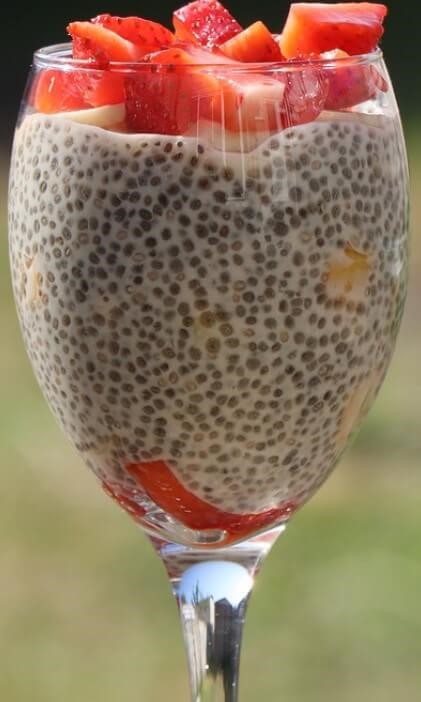
Image courtesy: needpix.com
2.) Rich Source of Omega-3 Fatty Acids
High in Omega-3 fatty acids, dietary fiber, protein, and calcium gives an impressive nutritional advantage to the chia seeds. It provides 34 g of dietary fiber (136% of DV) and 63% of calcium needs per 100 g. This makes chia seeds an essential part of your healthy diet.
3.) Improves Digestive Health
Chia seeds are when soaked in water forms a jelly-like substance. They help improve bowel movements, prevent constipation, and promote a healthy gut microbiome. A strong digestion system absorbs the nutrients properly.
4.) Antioxidant Benefits
The antioxidant properties of chia seeds help in fighting against oxidative stress and reduce the damage caused by free radicals. This reduces the risk of many chronic diseases.
5.) Chia Seeds Benefits in Weight Loss
Chia seeds expand in the stomach and give a feeling of fullness. They help in weight loss by reducing the constant eating and overall calorie intake.
6.) Chia Seeds Benefits for Bones
High amounts of calcium, magnesium, and phosphorus in chia seeds promote strong bones and prevent osteoporosis. This makes them ideal for skeletal and dental support.
What are Sabja Seeds?
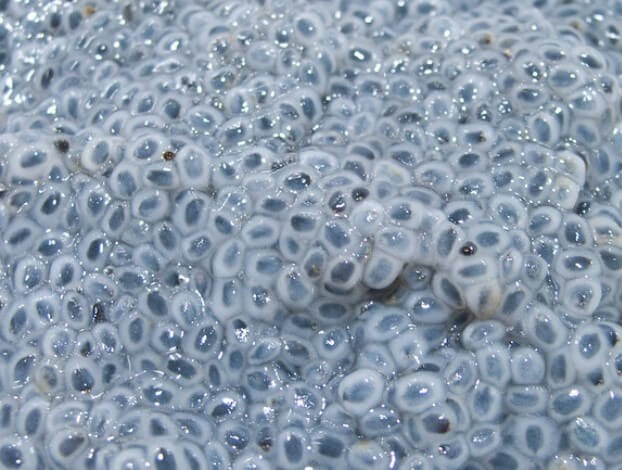
Image courtesy: flickr.com
Sabja seeds have been traditionally used in Ayurvedic and Chinese system of medicines. The botanical name of sabja seeds is Ocimum basilicum. They are also commonly known as basil seeds, falooda seeds, tukmaria seeds, and sweet basil seeds. Sabja seeds come from the sweet basil plant. They are small, oval-shaped and black in color and tastes mild and slightly sweet. Sabja seeds are mostly grown in India, China, and Mexico. They are often confused with the chia seeds but they have higher fiber content and lesser Omega-3 fatty acids.
Sabja Seeds Nutritional Value
Let us look at the nutritional information of sabja seeds and see where they fare well or low in comparison to chia seeds:

Also note:
- Sabja seeds have higher proportions of saturated, monounsaturated, and polyunsaturated fatty acids.
- It has higher alpha-linolenic acid.
- The total phenolic and flavonoid content in sabja seeds is higher than in chia seeds.
- The antioxidant potential of sabja seeds is higher than that of chia seeds.
Sabja Seeds Health Benefits
Sabja seeds have been a traditional medicine for stomach, vomiting, and urinary problems. It has antioxidant, anti-inflammatory, anticancer, antiviral, and antimicrobial properties.
1.) Aids in Heart Health
Studies on sabja seeds have demonstrated their efficacy in decreasing harmful fats like cholesterol and triglycerides in the blood of high-risk people. Omega-3 fatty acids in sabja seeds help lower LDL cholesterol and triglycerides. It promotes heart health by preventing atherosclerosis, a condition of the buildup of fats, cholesterol, and other substances in and on the artery walls causing a blocked blood flow.
2.) Sabja Seeds Benefits in Weight Loss
In over a 45 days treatment, sabja seeds were found effective in managing the weight.
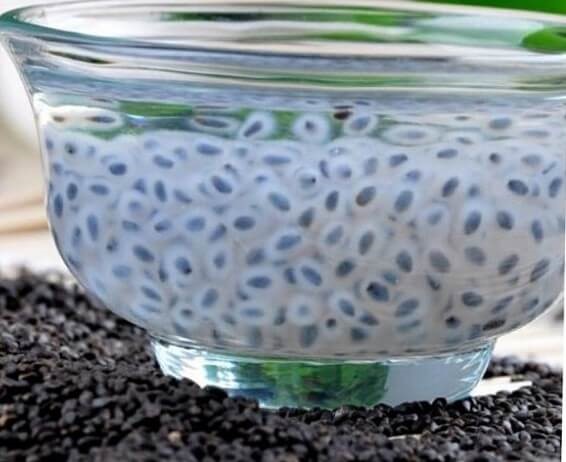
Image courtesy: Wikimedia.org
3.) Antioxidant Benefits
The powerful antioxidant property in sabja seeds help in detoxifying the body by removing the harmful substances. They also play a vital role in reducing the oxidative stress.
4.) Good for Digestion
When sabja seeds are soaked in the water they form a jelly like substance. This helps in relieving constipation and making digestion better.
5.) Sabja Seeds Benefits for Diabetics
In a study on diabetic and normal rats, sabja seeds have shown to reduce blood glucose levels.
6.) Anti-inflammatory Properties
The anti-inflammatory effects of sabja seeds contribute to the overall health by reducing the risk of chronic diseases.
Chia seeds vs Sabja Seeds Nutrition
The comparative nutritional information of chia seeds vs sabja seeds is tabulated below:
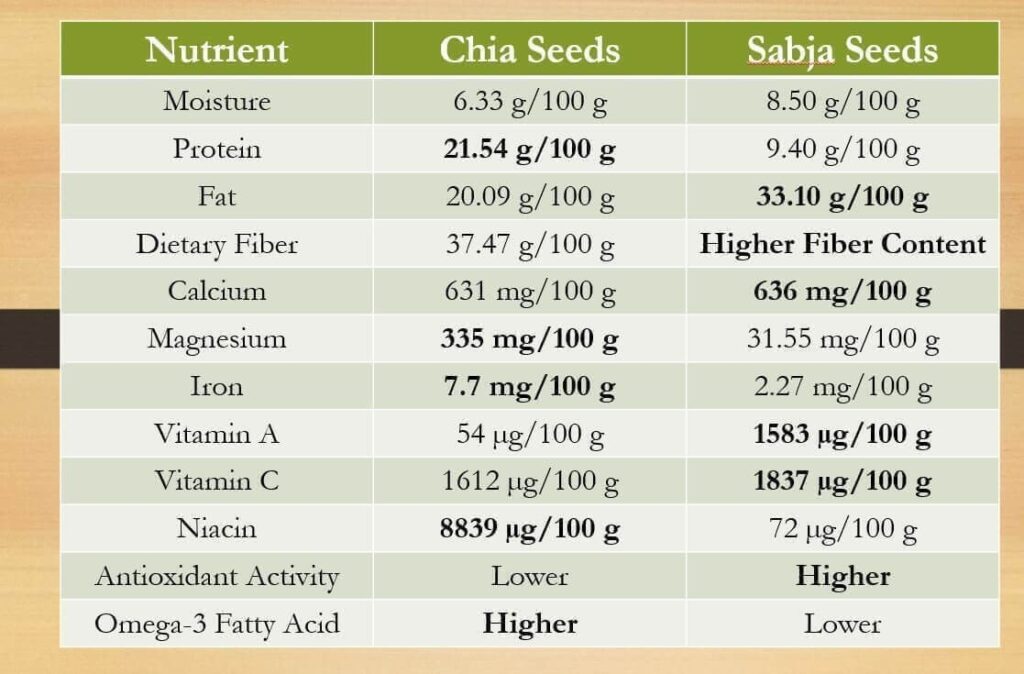
Health Benefits of Both Chia Seeds and Sabja Seeds
Let us see the combined benefits of chia and sabja seeds.
1.) Manages Blood Sugar
Both seeds form gel when soaked in the water. The gel slows down the digestion, leading to a gradual release of glucose in the blood. This helps in better management of blood sugar levels and provide long-lasting energy.
2.) Effective in Weight Loss
The gel forming ability of both chia seeds and sabja seeds gives the feeling of fullness and slows down the digestion. This prevents the constant urge of eating and helps in weight loss.
3.) Keeps Body Hydrated
Both seeds can be a good option to be included during summer or after exercise, since their gel-like texture help retain moisture in the body and keep you hydrated.
4.) Manages Diabetes
By slowing down the digestion, both seeds can prevent the spikes in the blood sugar levels. Both chia seeds and sabja seeds are excellent for managing Type 2 diabetes and its complications.
Chia Seeds Vs Sabja Seeds Which is Best/Better – Chia Seeds Vs Sabja Seeds Benefits
The comparable nutritional profile, bioactive compounds, and phytochemistry of chia and sabja seeds make it difficult for consumers to choose between them. However, both have immense benefits to offer to health and can cater to different needs. Having explored the individual and combined benefits of chia seeds and sabja seeds, it is easier to compare chia seeds vs sabja seeds.
Chia Seeds Vs Sabja Seeds Benefits – A Comparative Analysis
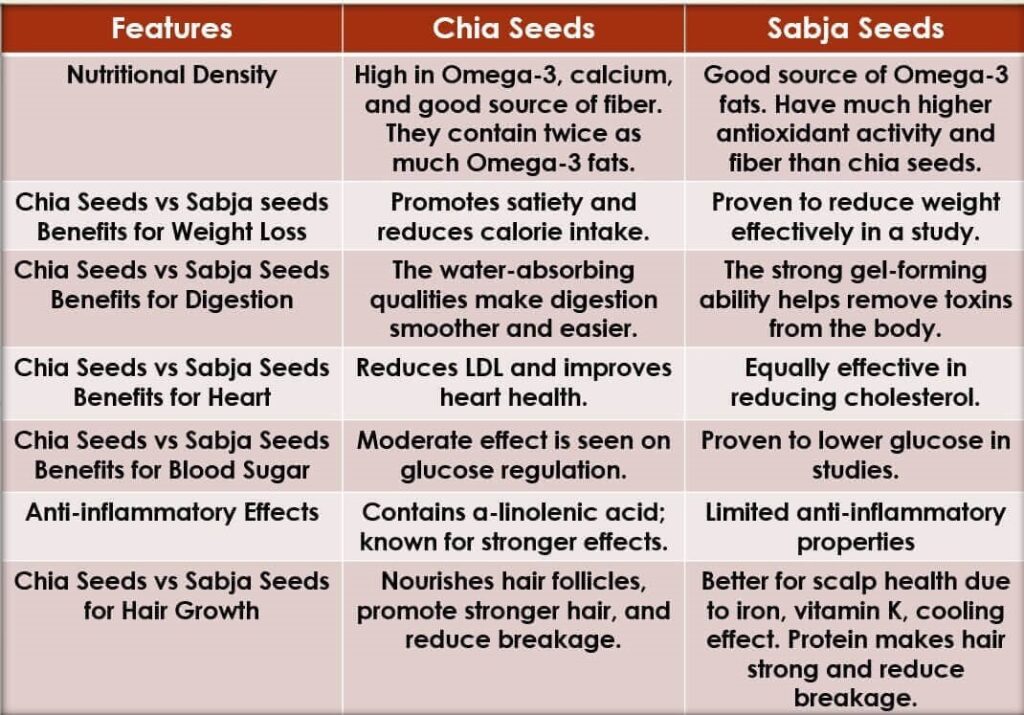
Key Takeaways of Chia Seeds Vs Sabja Seeds Benefits
- Choose Chia seeds if you want your diet to be nutrient-dense and fiber-rich and want to get the benefits of stronger bones, good digestion, and heart health.
- Incorporate sabja seeds in your diet to reduce weight and cholesterol along with a traditional remedy for digestive problems.
Also Read:
Takeaway Message
Chia seeds and sabja seeds are a powerhouse of nutrition and bioactive compounds. Consuming them can help you get rid of many diseases such as obesity, cardiovascular diseases, diabetes, cancer, etc. Important bioactive compounds found in both seeds include polyphenols, carotenoids, phytoestrogens, sterols, stanols, vitamins, dietary fiber, fatty acids, probiotics, prebiotics, and bioactive peptides. Understanding chia seeds vs sabja seeds benefits can help address specific health concerns more effectively. With the overlapping unique benefits of chia and sabja seeds, it is better to incorporate both seeds to get great health.
Disclaimer: The views expressed in this article should not be considered as a substitute for a physician’s advice. Please consult your treating physician for more details.
Do chia seeds or sabja seeds cause side effects?
Chia and sabja seeds are safe to consume when taken in moderation. However, excessive consumption may cause bloating or digestive issues.
Are chia seeds better for bone health?
Yes, due to higher calcium and magnesium levels.
Which is better for weight loss – chia seeds or sabja seeds?
Though chia seeds and sabja seeds aid in weight loss, sabja seeds top the list due to their higher fiber content.
Can chia seeds and sabja seeds be consumed together?
Yes, combining chia and sabja seeds enhances their nutritional benefits.
What are the key nutritional differences between chia and sabja seeds?
Chia seeds are rich in omega-3 fatty acids, fiber, and calcium, while sabja seeds (takmaria or basil seeds) are high in fiber and cooling properties. Both support digestion, but chia has more protein, while sabja is lower in calories. Both seeds have many health benefits. Overall, it also depends on your diet how beneficial each seed will be for you.
Which seed is better for hydration?
Sabja seeds have a very good texture and when soaked in water, they turn into a gel which is very good for hydration. They are also used in Falooda or lemon juice water. Chia seeds also absorb water but are denser, making sabja slightly better for quick hydration.
How do chia and sabja seeds support weight management?
Both seeds promote satiety due to their high fiber content, helping you feel full longer. Chia seeds provide sustained energy from healthy fats, while sabja seeds’ cooling effect may reduce cravings for heavy foods. Overall this will help in weight management if you follow a balanced diet.
Which seed is easier to incorporate into daily meals?
Chia seeds are versatile, blending into smoothies, yogurt, or baked goods. Sanja seeds are typically soaked and added to drinks or desserts. Chia’s neutral taste makes it more adaptable for various recipes.
Are chia or sabja seeds better for digestive health?
Both have high fiber which helps in digestion, but sabja seeds have a mild laxative effect, making them slightly better for relieving constipation. Chia seeds support gut health with prebiotic fiber for long-term benefits.


इनके बारे में पहली बार पढ़ा। बहुत ही लाभदायक।.साझा करने के लिए.शुक्रिया।
Thanks for your comments.